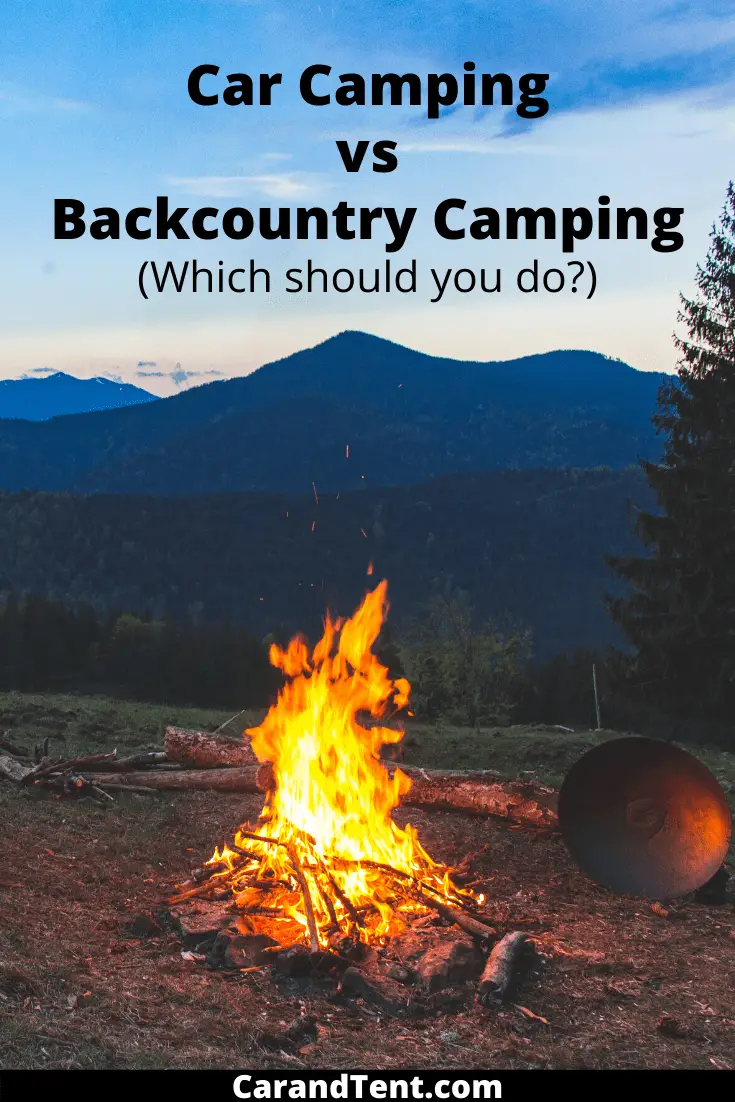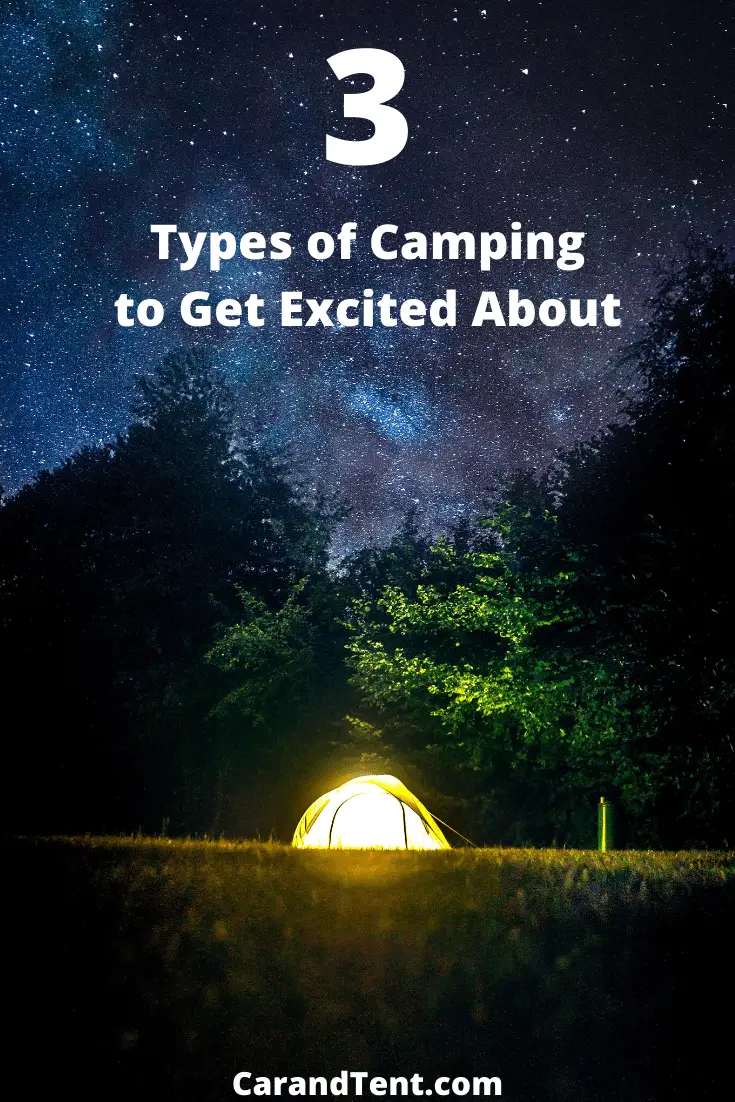The word camping can mean different things to different people. This is because there are different types of camping that people like to engage in.
Each type of camping has its advantages and disadvantages. In this post, we’ll go over these different types of camping so you can get a better feel for what type you’d like to do.
Table of Contents
Car Camping
Car camping is probably the most popular type of camping in the United States and possibly even the world. The reason for this is that it is the most accessible type of camping.
With car camping, you drive to the place you’ll be camping and you set up camp next to your car. For example, a car camper might drive to a campsite in a state park where they can park their car near a flat area with a fire pit and a picnic table.
Another example might be a car camper setting up camp in the desert on BLM land. In this case, a family might pull off of the road and set up camp just a short distance from a desolate highway.
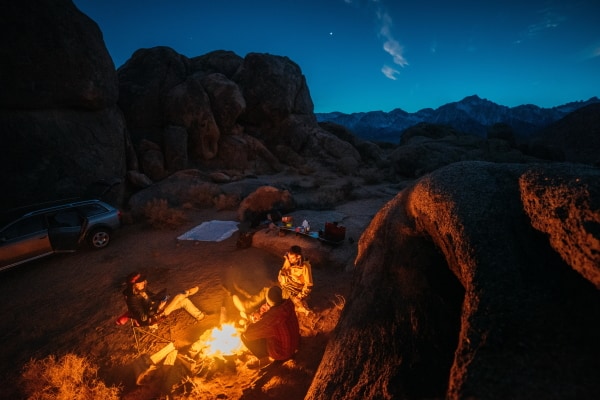
The Advantages of Car Camping
- It’s easy and accessible to everyone.
- You often have access to plumbing and electricity.
- It’s inexpensive.
- Trips can be short.
- Less planning is required.
- It’s easier to leave early.
Ease and Accessibility
Many people like to go car camping because of how easy and accessible it is for everyone. This means that entire families can go on trips together without a whole lot of training or planning.
The reason for this is campers do not have to hike or boat anywhere to get to their destination. As a result, even young kids, expecting mothers, the elderly, and physically handicapped people can go car camping. This gives everyone the chance to enjoy nature on their own terms.
Plumbing and Electricity
One of the most searched camping terms is “how to shower while camping“. This is second only to “where do I go to the bathroom while camping”. People love plumbing and many aren’t willing to give it up even if it’s just for a weekend.
A major benefit of car camping is that campers don’t have to give up their plumbing. Many car camping campgrounds have bathrooms in them with full showers.
Even ones that don’t often provide large enough campsites for people to bring their own portable toilets and showers. A backpacker won’t have the luxury of being able to drag out a portable toilet and enough water to shower with but a car camper doesn’t have these limitations.
Car camping campsites will often have electrical outlets connected to them as well. This gives car campers the ability to charge cell phones, play radios, and even hook up air conditioners for their tents. People who can work from home often prefer car camping as it gives them the chance to go camping without having to take off from work.
Cost
The cost of a car camping site can be as little as $15.00 for a rustic site. Even a campsite with electricity and plumbing might only cost $20.00 to $25.00 a night. These prices are often higher during peak season but even a $35.00 campsite is still much cheaper than a night at a hotel.
On top of this, car campers don’t need to buy a lot of expensive equipment. A car camper can buy a larger and heavier tent since he or she won’t have to carry it very far.
Food doesn’t have to be expensive either as it’s easy to grill up the same food that you’d cook at home right at your campsite. A backpacker or car camper, on the other hand, might have to buy an expensive backpacking tent as well as expensive freeze-dried meals. These expenses average out to be inexpensive over long periods of time but they can be quite costly when a person only wants to take one or two camping trips.
Short Trips
While it’s possible to take a short backpacking or canoe camping trip, it usually doesn’t make a whole lot of sense. The amount of planning that goes into a backpacking or canoe camping trip usually warrants at least a weekend adventure.
With car camping, you can pull up to a campsite with relative ease. In fact, most places won’t require you to book anything in advance so you can play a car camping trip by ear. For example, if you wake up one morning and the weather is really nice, you could easily throw your gear in your car and take a one day trip to a car camping destination.
Canoe camping trips and backpacking trips usually require much more coordination and planning so it isn’t always possible to plan a quick trip. In most cases, a backpacker will plan to spend at least a few days of camping in the woods.
Planning
A canoe camping trip usually involves outside participation. For example, a friend or a professional company might drop you into the water upstream and you might bring the canoe back to your car a few days later. Not only do you have to plan for the drop-off but you also have to plan to have a safe place for your car to be parked for when you return.
Backpacking trips often require even more planning. A backpacker might be camping in the wilderness for weeks at a time. During this time, the backpacker will need food and water to sustain them until they get back.
They’ll also have to have a plan for where they will leave their vehicle as well as where they’ll end their camping trip. For instance, some people will be picked up tens or even hundreds of miles from where they started while others will simply hike out into the woods and then hike back when they’re done.
Going Home
You can end a car camping trip simply by packing up your gear and going home. This means if the weather turns bad, you get sick, or you simply get bored, you can go home early.
With a backpacking or canoe camping trip, you may find yourself far from home without any way to quickly get back. For example, you might be thirty miles into the wilderness when the weather turns bad. In this case, you’ll need to hike thirty miles back out before you can head home.
The Disadvantages of Car Camping
- Less natural.
- Easier.
- It costs money.
Nature
Some people feel that car camping isn’t really camping at all. This is because you aren’t able to go very far into the wilderness with your car. As a result, you’re often very close to civilization and you may even be close to a nearby city or town. This isn’t true of all car camping sites but it is something to consider.
Additionally, car camping sites seem to be less rustic and more populated than backcountry camping sites. People who are willing to hike or paddle deep into the wilderness will find that they get to experience nature on a different level than car campers get to experience.
Less Challenging
Some people don’t like car camping because it’s not as challenging as the other types of camping. Adventure lovers might find they get a thrill out of traveling to their destination on foot or by watercraft and they lose this sense of adventure when they can just drive up to their campsite.
Also, some people like the challenges that come with not having electricity or plumbing nearby. These people find that they appreciate these things more after they’ve come back from a backcountry camping experience. With car camping, you don’t really have this opportunity as plumbing and electricity are often on-site.
Money
Car camping usually costs money. There are some car camping spots you can visit without paying a dime but for the most part, you’ll usually have to pay a daily rate to car camp.
For more information on the costs of car camping, see my post titled, “How Much Does It Cost To Go Camping“.
Canoe Camping
Canoe camping combines camping and canoeing and allows people to experience natural areas that aren’t accessible in any other way. Personally, it is one of my favorite types of camping as it’s easier than backcountry camping and more rustic than car camping so it’s a great middle-of-the-road option for most people.
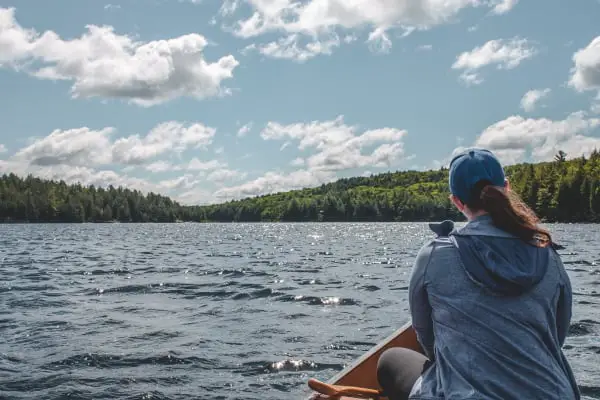
Canoe Camping Advantages
- Canoe campers get to explore natural wetland areas.
- A canoe camper gets to go into the backcountry without carrying all of their gear with them.
- You don’t have to be in great shape to go canoe camping.
- Most people find it more exciting than car camping.
- You can fish while you float towards your destination.
Wetland Areas
There are many natural wetland areas that simply can’t be explored on foot or by car. Some of these areas can’t even be explored on larger watercraft.
However, many of these areas can easily be accessed using small watercraft like canoes and kayaks. Go canoe camping and you can explore these areas and even stay the night in a place that most people will never even get to see.
Backcountry Camping Made Easy
As you’ll learn in the next section, backcountry camping has many benefits but it does require you to carry all of your gear into the backcountry. With canoe camping, your gear will sit in your canoe while you make your way into the wilderness. This makes it easier to get to isolated areas since you won’t have to carry all of your gear.
As a result, you don’t have to be in the best of shape to go canoe camping. In fact, in many areas, you won’t have to do much physical exercise at all as you’ll use the natural current of the river to take you downstream.
This being said, if you’re up for a workout, you can always choose a canoe camping trip that forces you to do more paddling. Doing so will add a bit of difficulty to your canoe camping trip which could make it more fun for you depending on your personal preferences.
Fishing and Camping
Canoe camping trips often turn into fishing trips as you can fish while you float towards your campsite. This makes the trip more fun and oftentimes you’ll arrive at your campsite with a freshly caught dinner in your canoe.
If you’d like to learn more about canoe camping, see my post titled, “The Beginner’s Guide to Canoe Camping“.
Disadvantages of Canoe Camping
- It takes more planning.
- Your trip is more reliant on good weather.
- It usually comes at the highest cost.
Planning a Canoe Camping Trip
A canoe camping trip requires more planning than a car camping or even a backcountry camping trip. The reason for this is that you have to have someone to drop you off upstream and you have to have someone to pick you up downstream.
Luckily, there are many professional companies that will do this for you in the more popular canoe camping areas. The downside to this is that areas with these companies are usually more crowded than areas that do not have these companies. If you truly want to head out into the deep wilderness, you may have to do a little more planning to get you to and from your start and end locations.
The Weather
Not too long ago, my brothers and I planned a canoe camping trip and the weather was going to be just perfect for it. I was looking forward to it and was disappointed when my brother called to tell me the drop-off company was recommending against it.
The reason for this was that we had gotten so much rain leading up to the trip that the river was too high and too fast to safely do a canoe camping trip on it. Not only this, but the islands that we would have camped on would have been flooded out at this point so we wouldn’t have had anywhere to camp for the night.
Weather events like this can play a role in other types of camping as well but it’s more likely to affect canoe camping trips than it is to affect other types of camping trips. A person can backcountry camp and car camp during a strong rainstorm in relative safety. The same can’t be said for traveling down a river in a canoe during a rainstorm.
Backcountry Camping
Backcountry camping is the only type of camping that camping purists will acknowledge. This is the type of camping where you hike into the woods with all of your gear on your back.
Once you get out into the wilderness, you create your own campsite for the night. Some people will hike out to one area and stay there for a few days while others will spend everyday backpacking and they’ll set up a new campsite each night.
A trip can be as short as one night out into the woods or it can last for months at a time. People who thru-hike the Appalachian Trail or the Pacific Crest Trail can spend up to five months hiking and camping. In return for hiking well over 2,000 miles, they’ll get to see parts of the country that others can only dream about.
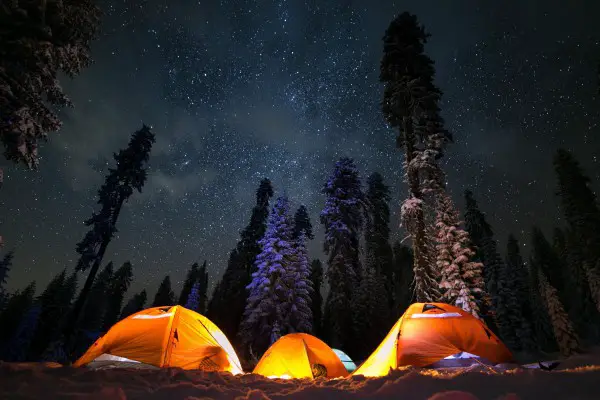
Advantages of Backcountry Camping
- You get to travel deep into the wilderness.
- You’re more likely to experience solitude.
- You have more opportunities to view wildlife.
- It usually doesn’t cost much to go backcountry camping.
- You get a much better workout.
Deep Wilderness Camping
When you go backcountry camping, you have the option to hike deep into the woods or even through uninhabitable desert areas. Wilderness camping gives you a totally different experience than car camping as you get to pick exactly where you’d like to set up camp.
It’s often more practical than canoe camping since you don’t have to rely on a stream or river to help you get to your destination. After all, you can’t easily combine canoe camping and desert camping on the same trip.
Solitude
For those of you looking to get away from it all and to experience some peace and quiet, backcountry camping is probably best. Not a lot of people are willing to hike out into the wilderness for fun and if you plan your trip correctly you may be able to go an entire trip without ever seeing another human being. While this might be terrifying for some people, it is a welcome change of pace for others.
Wildlife Viewing
The deeper you head out into the wild, the more likely it is that you’ll get to see wildlife. You can burn these experiences into your memory, or you can bring a nice camera with you so that you can take pictures to take home with you. In my experience, people who love backcountry camping often end up falling in love with nature and landscape photography as well.
The Cost of Backcountry Camping
Backcountry camping can often be done for free. Of course, you’ll need to rent or buy some gear to take along with you, but you won’t have to pay a campsite fee on top of that. This means that once you’ve acquired your basic camping gear, all trips from then on are essentially free.
Improved Physical Fitness
Backcountry camping is hard. You have to carry all of your gear on your back and you have to walk with it until you reach your destination. Depending on how far you decide to go, you could end up with a fantastic workout. Even a short one or two-mile trip into the woods with 30 to 50 pounds on your back can be a challenging experience.
Disadvantages of Backcountry Camping
- You have to be in decent shape to go backcountry camping.
- Backcountry camping comes with a higher risk than car camping.
- You can often completely lose access to modern technology and conveniences.
- You may have to ration your food and water.
Physical Limitations
Let’s face it, not everyone is physically capable of hiking up and down hills and valleys with a heavy backpack strapped to them. This means that some people will automatically be excluded from backcountry camping.
For these people, backcountry camping is currently a physical impossibility. In some cases, it’s just a matter of being in bad shape, for others it could be a disability. If this is the case, a nice car camping trip might be a better alternative to backcountry camping.
Higher Risk
Camping is a safe activity even when you do head out into the backcountry. This being said, things can happen and when you’re out in the wilderness it can be a bit more difficult to find help.
On top of this, you may have more encounters with wildlife. Most animals won’t bother you as long as your cautious but there are some rare occasions when a bear might attack or a snake might strike. When this happens 50 miles away from the nearest road, getting rescued becomes a little tougher.
Modern Technology
It’s good to get away from our computers and smartphones from time-to-time. However, if you’re looking to take a “working vacation”, you may find that you don’t have cell phone reception or internet access out on the trail. In this case, you’d be better off finding a car camping location that has wifi on-site.
Rationing
One of my favorite sayings when backpacking is that you can eat and drink as much as you can carry. Unfortunately, this often leads to rationing as most people simply can’t carry a lot of food and water for a prolonged backcountry camping trip.
Just remember, while you’re rationing your food, there is a group of campers at a car camping spot grilling up their favorite foods in excess.
Final Thoughts
Car camping, canoe camping, and backcountry camping are the three primary types of camping you can do. All three are fun and all three have there plusses and minuses. If you haven’t done all three yet, I’d encourage you to give them all a try.
If you haven’t camped at all yet, I’d suggest that you start out car camping, move onto canoe camping, and end with backcountry camping. This will put the three types in order from easiest to hardest.

